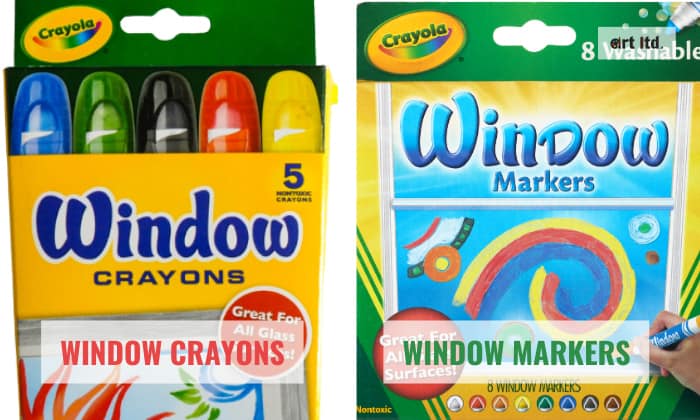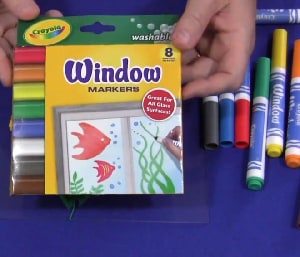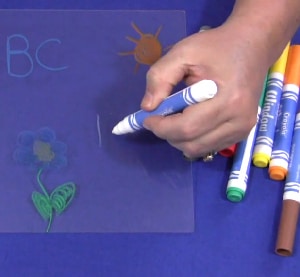Creativity is boundless when you have the right tools to work with. In a similar fashion, paintable surfaces aren’t just limited to canvas or paper. For instance, it’s not uncommon to draw on windows.
When it comes to decorating these glassy surfaces, two common options are window crayons vs window markers. As both do their job well, it can be confusing to decide which medium to use.
Although these art tools may seem identical, window markers and window markers have their respective characteristics that unravel their significant differences and uses. Let us delve into these aspects in this article.
Table of Contents
What is the Difference Between Window Crayons and Window Markers?
1. Window Crayons
Similar to regular crayons, window crayons feature a waxy texture and finish. However, they are encased in plastic barrels, so they may look similar to traditional markers at first glance.
These crayons can create quick-drying vibrant colors that don’t smudge when drawn on non-porous surfaces. That said, the hues can stick to your skin and fabric surfaces easily, leaving messy stains. Thankfully, the pigments are washable with wet wipes.
As window crayons are primarily designed for children, they are formulated with non-toxic ingredients.
The only downside is their tendency to leave messy stains because they transfer easily to the skin and fabric surfaces.
2. Window Markers
Window markers are available in a wide range of types, making them suitable for various non-porous surfaces, including windows and glass. Chalk markers, dry-erase markers, and glass markers are some of the popular types.
Contrary to window crayons, these markers utilize ink to write temporary window marker designs for colorful and creative signage and embellishments. They can easily be wiped clean, leaving no messy stains, smudges, or color transfers.
However, keep in mind that certain window markers, especially ones featuring alcohol-based ink, have a strong odor and may contain alcohol or solvents that can be toxic for kids.
Breakdown of Features
1. Composition and texture
When comparing crayons and markers for windows, you can easily recognize the difference in composition.
Window crayons have soft and waxy textures similar to regular crayons. No skip, bleed, or leak issues since they do not depend on ink reservoirs to create colors. Hence, they’re pretty easy to use.
Window markers rely on ink barrels to deliver pigmented fluid in various line weights. Depending on the brand or how they are stored and used, markers may leak and leave streaks.
2. Color and appearance
Both window crayons and markers create bright and pigmented colors. The finish, however, differs due to their composition.
As the name suggests, window crayons produce smooth and creamy textures but can be a bit flaky at times if you apply too much color in one spot.
Markers to write on windows render sharp and clean lines in vivid hues. The availability of different nib sizes makes them versatile, allowing these markers to create thick and thin strokes.
Both types come in different colors, but window crayons have a limited selection. To elaborate, there are only 5 window crayon colors so far: blue, green, black, red, and yellow.
In contrast, window markers offer vast color choices for more vibrant markings, greetings, graduation window markers ideas, or decorations.
3. Surface compatibility
Window crayons are designed for windows, mirrors, car windows, and other glass surfaces. Therefore, these crayons are an excellent alternative to markers for car windows and non-porous surfaces with similar finishes.
Similarly, there are various types of markers to use on windows and other non-porous surfaces, including metal, plastic, glass, painted surfaces, or varnished wood.
4. Variation
Liquid chalk markers, dry-erase markers, and glass pens are some common types of erasable window markers. They are typically better suited for artistic decorations on window spaces or for special events, such as graduation window marker ideas.
Meanwhile, as of the time of writing, the only brand to produce window crayons is Crayola. To improve your artwork’s aesthetic, consider pairing the crayons with markers, such as the Crayola Crystal Effects Window Markers.
5. Erasability and cleanup
Due to their oily and creamy textures, window crayons do not come off as neatly as window markers do. Although they do come off eventually on windows or glass surfaces, they tend to leave residues when not thoroughly cleaned. A damp towel or wet wipe will do the trick.
Aside from that, window crayons easily stain hands and may transfer colors to fabric surfaces like couches, clothes, or pillows. Nonetheless, they can still be removed with scrubbing or washing, albeit a little time-consuming.
Markers for glass windows, on the other hand, usually come off nicely and seamlessly on non-porous surfaces with a clean cloth or paper towel.
6. Safety
Window crayons are non-toxic, making them a much safer option for interactive coloring or window decorating with children. Window markers can also be used around children under the supervision of adults.
Although non-toxic window markers are available, some window markers contain alcohol and other chemical ingredients that may cause health hazards to kids.
7. Cost
A 5-pack set of Crayola window crayons costs nearly $12, while an 8-pack set of window markers from the same brand will only set you back around $6.
Even if you’re getting window markers from other brands, Crayola crayons are still likely to be more expensive. For example, Expo 5-pack dry-erase and Chalktastic 8-pack window markers both cost $10. Similarly, a set as large as the Toru 24-color window coloring pens is only $24.
Pros & Cons
Window Crayons
- Bold and creamy textures similar to regular crayons
- Erasable
- Compatible with windows, mirrors, and other glass surfaces
- Easy to use
- Non-toxic and safe for children
- Can be flaky sometimes
- Easily stains hands and transfers colors to fabric surfaces
- Limited color options
Window Markers
- Vibrant colors and sharp lines
- Easy and neat cleanup
- Suitable for windows and other non-porous surfaces
- Available in different types
- Wide color selection
- Prone to leak, bleed and skip issues
- Some options are toxic
Frequently Asked Questions
Do window markers wash off easily?
Although window markers come in different types, all of them are washable and can easily be cleaned with a clean cloth, damp cloth, or alcohol wipes.
Can Crayola markers be used on windows?
As long as they are designed for windows or are erasable, they can be used on windows. Take note that Crayola has a vast lineup of markers that are intended for different purposes.
Can window crayons be used on mirrors?
Yes. Mirrors are essentially similar to glasses, so you can use window crayons on these reflective surfaces with next to no problem.
Are window markers safe for cars?
If the window markers are specifically designed for cars, they are safe to use. However, make sure to always check the labels for specifications to prevent any damage.
Some window markers are intended only for particular areas of a car, such as the paint or window. Thus, incorrect applications may result in damages.
Conclusion
As we unfold the best features and uses in this comprehensive review of Window Crayons vs Window Markers, we have learned that they both stand out with their special characteristics.
Window crayons are bold and creamy like ordinary crayons, while window markers use ink to create vibrant and effortless markings. They are both erasable and easy to use.
Although they differ from one another, one thing’s for sure: window crayons and window markers revamp your creative spaces with colorful and imaginative arts and crafts.

Art has always been a part of my life; it influences my upbringing and later my career choice. For me, it is always a part of my parenting technique. So for whichever purpose that you come to art, you can start here with us.









